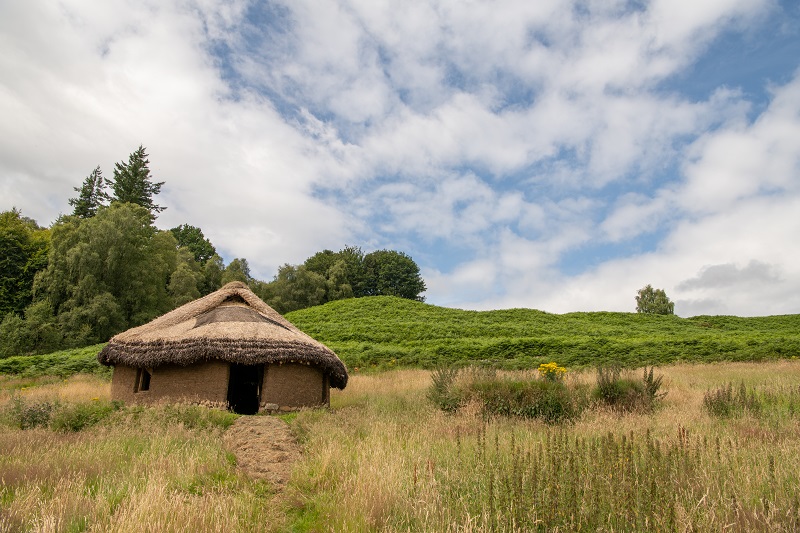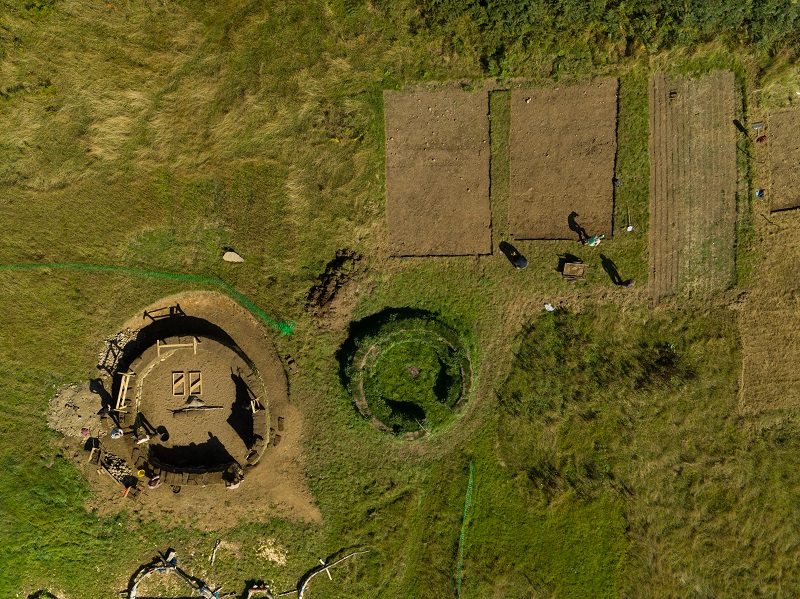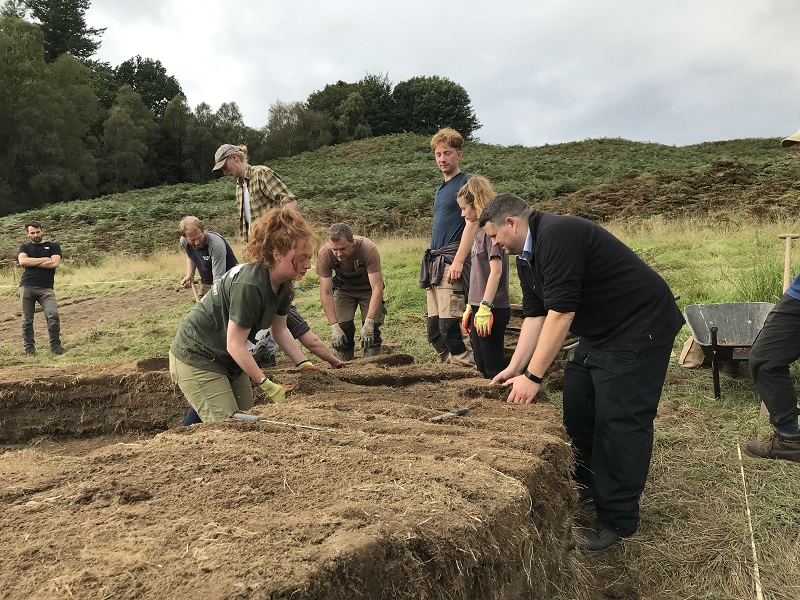Grassroots hutting: an architecture borrowed from the soil
Materials, Skills, Sustainability, Vernacular and earth building | Written by: Graham Briggs | Wednesday 24 January 2024

How can local materials and ancient skills help us with sustainable building practices for the modern age? That’s a question we explored by constructing a traditional turf hut near Comrie, Perthshire.
Over the past year, we’ve worked with a range of partners to build a traditional turf hut in the Perthshire countryside. Borrowed from the soil, at the end of it’s life the hut will melt back into the earth. But it’s legacy will leave a lasting impact on local communities, traditional builders, and building practices for the future.
Update your personalised ad preferences to view content
Hutting in Scotland
“A hut: a simple building used intermittently as recreational accommodation (i.e. not a principal residence); having an internal floor area of no more than 30 metres squared; constructed from low impact materials; generally not connected to mains water, electricity or sewerage; and built in such a way that it is removable with little or no trace at the end of its life.” – Scottish Planning Policy 2014
The tradition of recreational hutting in Scotland goes back to the 1920s when people would seek to escape the cities and towns for a return to nature. The Carbeth hutting community was established in the 1920s to provide a space in nature for returning soldiers. It continues to thrive to this day.

Examples of early huts in the Carbeth Hutting Community.
While hutting in Scotland has been in decline, ‘recreational hutting’ has seen a resurgence in recent years as people seek to create bolt holes and retreats that allow them to re-engage with nature and escape modern living for short periods of time. Reforesting Scotland’s 1000 huts project has revitalised interest in recreational hutting across Scotland in recent years.
The design of our grassroots hut
The project was inspired by this hutting tradition. Traditionally huts were built using materials that were locally available at the time. In contrast, hutting builds today have embraced modern methods of construction and are often fabricated off site and delivered, rather than built of materials from the land. Our project seeks to challenge this narrative by making a structure using vernacular (local) materials sourced from the site itself to create a low impact, low carbon habitable space.
Why a roundhouse? While this design is based on archaeological remains of an Iron Age roundhouse common in Perthshire, it’s not a replica or an archaeological reconstruction. The design is a modern interpretation that demonstrates what is possible using ancient skills and local materials from nature.
The great materials challenge!
We started with a survey of local materials and this determined what we used to create the hut. As a result, the materials used to build the hut came from within a few hundred metres of the site (even less in many cases).
The turf was cut directly beside the hut’s final location, and the bracken sourced from the field above the site. The timber (birch) was sourced from a nearby woodland. These are natural materials which need minimal processing. However, where processing of the materials was necessary, such as the stripping the leaves of the bracken and building the frames out of the birch, this was done on site.

The site, showing the half constructed hut, as well as the timber frame yet to be installed. Turf is being harvested right next to the site at the top right. The green, circular structure in the centre is a turf-walled bench we trialed earlier.
While many would view such material constraints as being too challenging, this is how our ancestors created their homes and worked their land. It is this simplistic approach to sourcing materials locally that has created Scotland’s historic built environment today. It is also this approach that ensured that these structures had minimal impact on the natural environment and wider landscape. It is through projects like this grassroots hut that we can relearn the role that traditional, natural materials can play in modern construction and their potential to create new buildings with minimal impact to the environment.
At the end of the buildings life, these materials will melt back into the land and return to the earth: ‘an architecture borrowed from the soil’. This is what makes the approach circular, similar to historic use of land.

The grass bench (slightly darker patch of grass to the right of the hut) has started to melt back into the landscape and is almost invisible within the meadow. The bracken that was harvested the previous winter to provide roofing material has regrown.
Skills and training
“The project aims to embed the protection of traditional craft skills as intangible heritage into positive climate action, building resilience and new capacities in local communities and professional practice.”
Dr Tanja Romankiewicz, Project Director, University of Edinburgh
This project aimed to train a community and enhance their knowledge and skills around traditional materials and techniques. Historically, working on buildings like this would have been part of everyday life, with the necessary knowledge and experience passed down through generations. The build created an opportunity for those who are interested to learn new skills and to connect with the people of the past. They, too, can now pass down their knowledge and experience.
Eight-week long practical workshops gave local people the opportunity to develop practical skills on live-build projects – a rare opportunity these days. The workshops were funded by the UKRI Economic and Social Research Council (ESRC) through an Impact Acceleration Grant, held by the University of Edinburgh.
Developing small projects like this grassroots hut creates opportunities for people to get together and share knowledge, relearn skills through trial and error and pass on their experience to future generations of vernacular builders.
“I’m very excited to see how the local communities, as they’re starting to take ownership of this building, are looking to move it forward and transform it from a skills exercise into a finished structure that can serve a modern purpose” – Daniel Postma, Archaeo Build

Workshop participants are working on a turf wall. Most work was done without machinery, relying on traditional hand skills.
Meeting Net Zero
Materials and where they are sourced, how they are processed, and where they will end up, will need to be at the forefront of the discussion around how Scotland transitions to net zero. Small structures like the grassroots hut demonstrate what is possible with natural materials, an extremely local supply chain and skills by the local community.
While it may not be possible for us all to build our own turf huts, every turf block built instead of steel or concrete is one block closer to reducing the carbon footprint of the building industry. We can continue to pass down age-old skills through the generations, and find innovation and inspiration in the earth.
Thank you to our partners and funders:
Find out more about the Grassroots Hutting Project. Learn more about earth as a building material in Scotland and explore five thatched buildings in Scotland you need to know about. If you’re considering building a hut, explore free resources on the 1000 huts website.
Learn more about vernacular building at our Vernacular Building Materials in Scotland event on Thursday 14 March 2024.
- Share this:
- Share this page on Facebook
- Share on X
About the author:
Graham Briggs
Graham Briggs is our Project Manager for Skills and Materials.
View all posts by Graham Briggs



